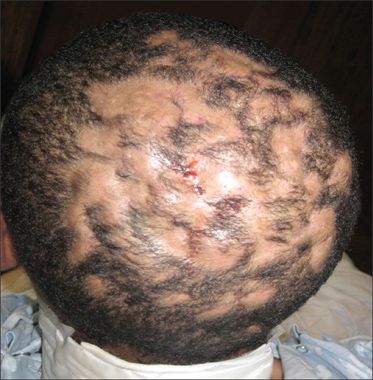Dissecting Cellulitis of the Scalp
For the past 7 years, a 32-year-old African-American man had multiple nonpruritic scalp abscesses. He also reported intermittent fever and joint pain. The abscesses had been drained on many occasions, and he had received several antibiotics, although no organisms had been isolated. Collagen vascular disease, SAPHO syndrome (synovitis, acne, pustulosis, hyperostosis, osteitis), discoid lupus, and cutaneous sarcoid had been ruled out. During the past 7 years, he had been treated with prednisone, methotrexate, and hydroxychloroquine without any response.

For the past 7 years, a 32-year-old African American man had multiple nonpruritic scalp abscesses. He also reported intermittent fever and joint pain. The abscesses had been drained on many occasions, and he had received several antibiotics, although no organisms had been isolated. Collagen vascular disease, SAPHO syndrome (synovitis, acne, pustulosis, hyperostosis, osteitis), discoid lupus, and cutaneous sarcoid had been ruled out. During the past 7 years, he had been treated with prednisone, methotrexate, and hydroxychloroquine, without any response.
Fungal cultures were negative for Microsporum and Trichophyton, and no nuchal lymph nodes were palpable.1 Folliculotropic mycosis fungoides with large-cell transformation2 was unlikely because the patient did not have any other systemic symptoms. Fluid from incision and abscess drainage revealed abundant neutrophils and red blood cells with no evidence of malignancy. Cultures and stains were negative for bacteria and fungi. The diagnosis of exclusion was dissecting cellulitis of the scalp.
The differential diagnosis of this condition includes acne keloid,3 which is associated with chronic, scarring folliculitis that affects mostly African American patients and is located on the back of the neck of young adults. The course is progressive and leads to hypertrophic scarring, chronic abscesses, and hair loss. Pseudopelade of Brocq,4 characterized by its lack of atrophy and "footprints in the snow" alopecia morphology, is another condition in the differential that generally occurs in white patients.
Dissecting cellulitis is difficult to treat. Medical therapies include antibiotic soap (chlorhexidine and benzoyl peroxide), dapsone, intralesional triamcinolone, zinc supplements, topical and oral isotretinoin, oral antibiotics (tetracycline and doxycycline), and oral corticosteroids. Simple incision and drainage and wide excision with split-thickness skin grafting have been used to treat severe cases when medical therapy has failed.
References:
REFERENCES:
1.
Padilha-Gonçalves A. Inflammatory tinea capitis (kerion) mimicking dissecting cellulitis.
Int J Dermatol
. 1992;31:66.
2.
Gilliam AC, Lessin SR, Wilson DM, Salhany KE. Folliculotropic mycosis fungoides with large-cell transformation presenting as dissecting cellulitis of the scalp.
J Cutan Pathol
. 1997;24:169-175.
3.
Luz Ramos M, Muñoz-Pérez MA, Pons A, et al. Acne keloidalis nuchae and tufted hair folliculitis.
Dermatology
. 1997;194:71-73.
4.
Collier PM, James MP. Pseudopelade of Brocq occurring in two brothers in childhood.
Clin Exp Dermatol
. 1994;19:61-64.